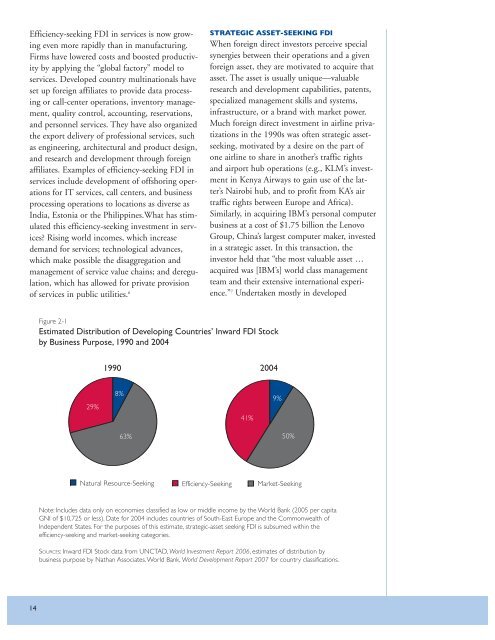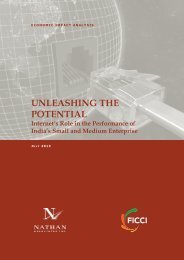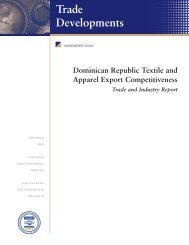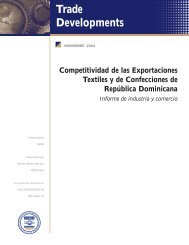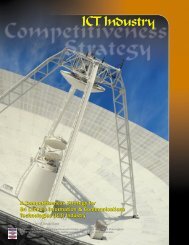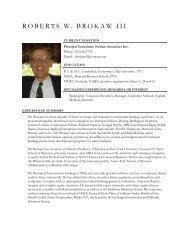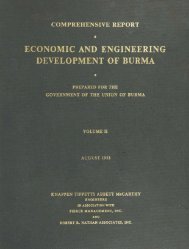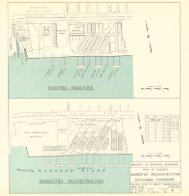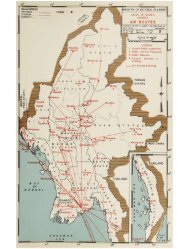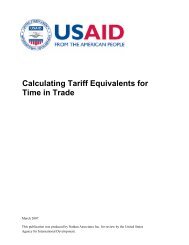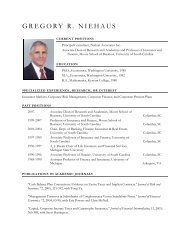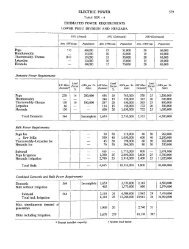Putting it to Work in Developing Countries - Nathan Associates
Putting it to Work in Developing Countries - Nathan Associates
Putting it to Work in Developing Countries - Nathan Associates
Create successful ePaper yourself
Turn your PDF publications into a flip-book with our unique Google optimized e-Paper software.
Efficiency-seek<strong>in</strong>g FDI <strong>in</strong> services is now grow<strong>in</strong>g<br />
even more rapidly than <strong>in</strong> manufactur<strong>in</strong>g.<br />
Firms have lowered costs and boosted productiv<strong>it</strong>y<br />
by apply<strong>in</strong>g the “global fac<strong>to</strong>ry” model <strong>to</strong><br />
services. Developed country mult<strong>in</strong>ationals have<br />
set up foreign affiliates <strong>to</strong> provide data process<strong>in</strong>g<br />
or call-center operations, <strong>in</strong>ven<strong>to</strong>ry management,<br />
qual<strong>it</strong>y control, account<strong>in</strong>g, reservations,<br />
and personnel services. They have also organized<br />
the export delivery of professional services, such<br />
as eng<strong>in</strong>eer<strong>in</strong>g, arch<strong>it</strong>ectural and product design,<br />
and research and development through foreign<br />
affiliates. Examples of efficiency-seek<strong>in</strong>g FDI <strong>in</strong><br />
services <strong>in</strong>clude development of offshor<strong>in</strong>g operations<br />
for IT services, call centers, and bus<strong>in</strong>ess<br />
process<strong>in</strong>g operations <strong>to</strong> locations as diverse as<br />
India, Es<strong>to</strong>nia or the Philipp<strong>in</strong>es.What has stimulated<br />
this efficiency-seek<strong>in</strong>g <strong>in</strong>vestment <strong>in</strong> services<br />
Ris<strong>in</strong>g world <strong>in</strong>comes, which <strong>in</strong>crease<br />
demand for services; technological advances,<br />
which make possible the disaggregation and<br />
management of service value cha<strong>in</strong>s; and deregulation,<br />
which has allowed for private provision<br />
of services <strong>in</strong> public util<strong>it</strong>ies. 6<br />
STRATEGIC ASSET-SEEKING FDI<br />
When foreign direct <strong>in</strong>ves<strong>to</strong>rs perceive special<br />
synergies between their operations and a given<br />
foreign asset, they are motivated <strong>to</strong> acquire that<br />
asset. The asset is usually unique—valuable<br />
research and development capabil<strong>it</strong>ies, patents,<br />
specialized management skills and systems,<br />
<strong>in</strong>frastructure, or a brand w<strong>it</strong>h market power.<br />
Much foreign direct <strong>in</strong>vestment <strong>in</strong> airl<strong>in</strong>e privatizations<br />
<strong>in</strong> the 1990s was often strategic assetseek<strong>in</strong>g,<br />
motivated by a desire on the part of<br />
one airl<strong>in</strong>e <strong>to</strong> share <strong>in</strong> another’s traffic rights<br />
and airport hub operations (e.g., KLM’s <strong>in</strong>vestment<br />
<strong>in</strong> Kenya Airways <strong>to</strong> ga<strong>in</strong> use of the latter’s<br />
Nairobi hub, and <strong>to</strong> prof<strong>it</strong> from KA’s air<br />
traffic rights between Europe and Africa).<br />
Similarly, <strong>in</strong> acquir<strong>in</strong>g IBM’s personal computer<br />
bus<strong>in</strong>ess at a cost of $1.75 billion the Lenovo<br />
Group, Ch<strong>in</strong>a’s largest computer maker, <strong>in</strong>vested<br />
<strong>in</strong> a strategic asset. In this transaction, the<br />
<strong>in</strong>ves<strong>to</strong>r held that “the most valuable asset …<br />
acquired was [IBM’s] world class management<br />
team and their extensive <strong>in</strong>ternational experience.”<br />
7 Undertaken mostly <strong>in</strong> developed<br />
Figure 2-1<br />
Estimated Distribution of Develop<strong>in</strong>g <strong>Countries</strong>’ Inward FDI S<strong>to</strong>ck<br />
by Bus<strong>in</strong>ess Purpose, 1990 and 2004<br />
1990 2004<br />
29%<br />
8%<br />
41%<br />
9%<br />
63%<br />
50%<br />
Natural Resource-Seek<strong>in</strong>g Efficiency-Seek<strong>in</strong>g Market-Seek<strong>in</strong>g<br />
Note: Includes data only on economies classified as low or middle <strong>in</strong>come by the World Bank (2005 per cap<strong>it</strong>a<br />
GNI of $10,725 or less). Date for 2004 <strong>in</strong>cludes countries of South-East Europe and the Commonwealth of<br />
Independent States. For the purposes of this estimate, strategic-asset seek<strong>in</strong>g FDI is subsumed w<strong>it</strong>h<strong>in</strong> the<br />
efficiency-seek<strong>in</strong>g and market-seek<strong>in</strong>g categories.<br />
SOURCES: Inward FDI S<strong>to</strong>ck data from UNCTAD, World Investment Report 2006, estimates of distribution by<br />
bus<strong>in</strong>ess purpose by <strong>Nathan</strong> <strong>Associates</strong>. World Bank, World Development Report 2007 for country classifications.<br />
14


